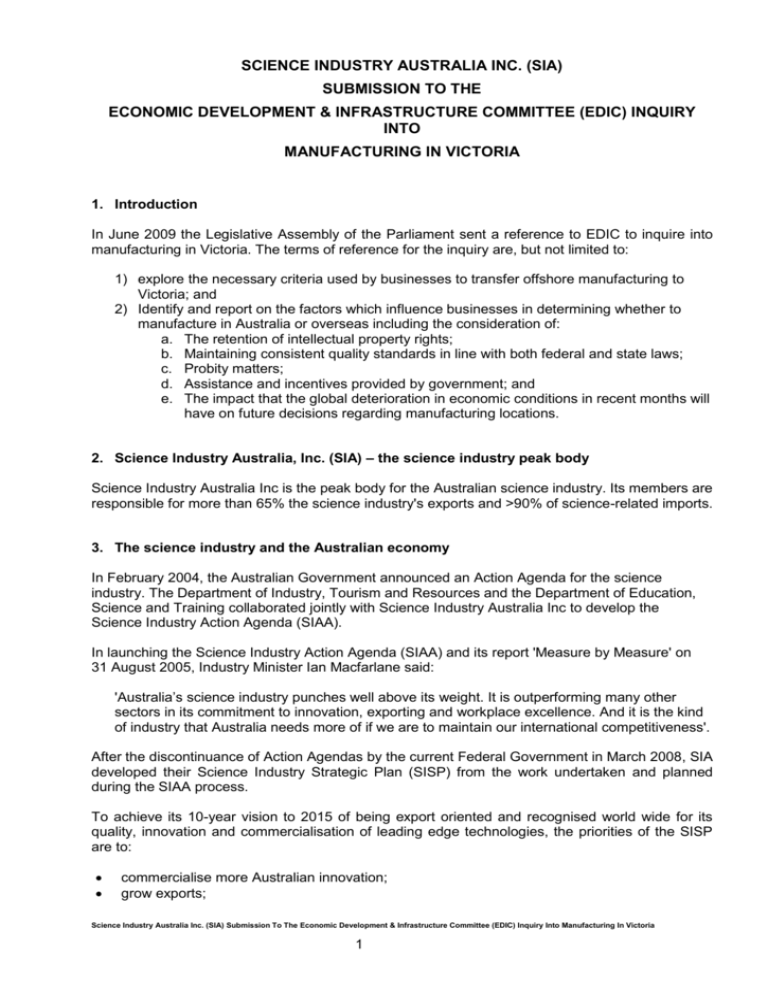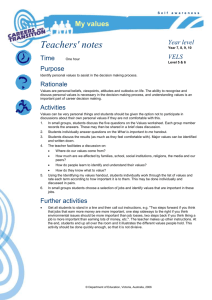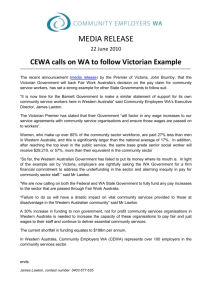Science Industry Australia Inc. (SIA) submission to the ECONOMIC
advertisement

SCIENCE INDUSTRY AUSTRALIA INC. (SIA) SUBMISSION TO THE ECONOMIC DEVELOPMENT & INFRASTRUCTURE COMMITTEE (EDIC) INQUIRY INTO MANUFACTURING IN VICTORIA 1. Introduction In June 2009 the Legislative Assembly of the Parliament sent a reference to EDIC to inquire into manufacturing in Victoria. The terms of reference for the inquiry are, but not limited to: 1) explore the necessary criteria used by businesses to transfer offshore manufacturing to Victoria; and 2) Identify and report on the factors which influence businesses in determining whether to manufacture in Australia or overseas including the consideration of: a. The retention of intellectual property rights; b. Maintaining consistent quality standards in line with both federal and state laws; c. Probity matters; d. Assistance and incentives provided by government; and e. The impact that the global deterioration in economic conditions in recent months will have on future decisions regarding manufacturing locations. 2. Science Industry Australia, Inc. (SIA) – the science industry peak body Science Industry Australia Inc is the peak body for the Australian science industry. Its members are responsible for more than 65% the science industry's exports and >90% of science-related imports. 3. The science industry and the Australian economy In February 2004, the Australian Government announced an Action Agenda for the science industry. The Department of Industry, Tourism and Resources and the Department of Education, Science and Training collaborated jointly with Science Industry Australia Inc to develop the Science Industry Action Agenda (SIAA). In launching the Science Industry Action Agenda (SIAA) and its report 'Measure by Measure' on 31 August 2005, Industry Minister Ian Macfarlane said: 'Australia’s science industry punches well above its weight. It is outperforming many other sectors in its commitment to innovation, exporting and workplace excellence. And it is the kind of industry that Australia needs more of if we are to maintain our international competitiveness'. After the discontinuance of Action Agendas by the current Federal Government in March 2008, SIA developed their Science Industry Strategic Plan (SISP) from the work undertaken and planned during the SIAA process. To achieve its 10-year vision to 2015 of being export oriented and recognised world wide for its quality, innovation and commercialisation of leading edge technologies, the priorities of the SISP are to: commercialise more Australian innovation; grow exports; Science Industry Australia Inc. (SIA) Submission To The Economic Development & Infrastructure Committee (EDIC) Inquiry Into Manufacturing In Victoria 1 improve quality; progress regulation reform; attract and retain a skilled and flexible workforce; and improve the industry’s internal and external linkages. The science industry is defined as research and development, design, production, sale and distribution of laboratory-related goods, services and intellectual capital used for measurement, analysis and diagnosis. Australia’s science industry comprises manufacturers and importer/distributors of scientific equipment, laboratory and technical service companies and the scientific research community. Measurement matters. Australia's science industry is a key enabler of many other industries. Its equipment and laboratory services provide for the measurement and identification of very low quantities of substances to ensure the quality of our food, water, air, environment, health and many other aspects of our daily lives. Its products and services are used by industries such as agri-food; resources; environmental monitoring; manufacturing; medical and health care; research and development and education. Australia’s domestic market for scientific equipment and laboratory-related services is estimated to be $11.78 billion in 2009/10. Australia's market represents an estimated 2 per cent of the global market, compared with Australia's gross domestic product (GDP) being around 1 per cent of global GDP. Australia's production of science services is estimated to be one-half of its production of science goods and services. Employment, including researchers and laboratory and technology service providers, is approximately 47 000. Science services production was $7.45 billion, of which exports are $303 million, and employment is 39 000. Australia’s publicly-funded researchers also provided significant services to the industry. Manufacturing production is $1.38 billion, exports $1.27 billion, imports $3.31 billion and employment 8 000. Australia’s scientific product manufacturers produce $110 million of the $3.31 billion domestic market for scientific products. Importantly, over 70% of science industry manufacturing occurs within Victoria generally, and in Melbourne’s eastern and south eastern suburbs, specifically. Australia's science industry is outperforming many other industries in terms of its growth, innovation, exports and workplace excellence. The industry is growing at an annual rate of 11 per cent. Its laboratory and technical services companies invest 5.9 per cent of their turnover in R&D. Its manufacturers invest 7.9 per cent of their turnover in R&D, which is 10 times Australia's manufacturing industry average. This is consistent with high performing manufacturers in Canada and United Kingdom. The larger science manufacturing companies export up to 97 per cent of their production. Almost 50 per cent of the industry's workforce has a university degree, and the industry spends more than 5 per cent of its turnover on training. The science industry is well integrated with global supply chains. Its scientific instruments, clinical diagnostics and laboratory services are globally recognised as the best available and used extensively in by the world's best companies. Its larger science manufacturing companies export up to 97 per cent of their production. Australian science industry manufacturers that compete globally include Aim Lab, GBC Scientific Equipment Pty Ltd, Leica Biosystems, Rofin, Photron, Aqua Diagnostics, Ecotech, Invetech, SGE Analytical Science and Varian. Australia’s laboratory and technical services companies provide a range of laboratory-related services that involve measurement, analysis and diagnosis. Companies that provide product Science Industry Australia Inc. (SIA) Submission To The Economic Development & Infrastructure Committee (EDIC) Inquiry Into Manufacturing In Victoria 2 maintenance and service are also included in this industry segment. The main types of services sold by laboratory and technical services companies are environmental and chemical analysis, technical services, and pathology/diagnostic services, and materials characterisation. The main customers of laboratory and technical services companies are environment, engineering, mining and healthcare (pathology testing and medical/health). Significant Australian companies with international operations engaged in providing laboratory and technical services include Amdel Pty Ltd, ALS Laboratory Group, Healthscope (Gribbles Group) and Sonic Healthcare Ltd. This knowledge-intensive global industry relies heavily on its investment in research and development and innovation more generally to provide a continuous supply of high value-added world-competitive products, processes and services. This investment must continue for the industry to remain globally competitive. Innovation services, such as research and development (R&D) from universities and publicly funded research agencies (PFRAs), necessarily support the industry's sustainable competitive advantage. A current underpinning research direction is the development of 'lab on a chip' measurement devices that will take a low-volume high-value production to high-volume low-cost with the potential to spawn a new industry in Australia. Supporting the emergence of this technology are global security issues and the need to have cheap, mobile devices that can check for all types of contaminants. With the growth in off-shoring of low technology manufacturing, Australia's science industry technology services offer significant potential to generate growth and prosperity of Australia during all economic cycles of Australia's resources industry. Laboratory and technology services either bundled with scientific equipment or as scientific services in their own right, are a growing component of science exports. The SISP priorities of particular relevance to this inquiry are commercialising more Australian innovation, growing exports, progressing regulation reform, and attracting and retaining a skilled and flexible workforce. The impediments and policy developments necessary for Australia to realise greater opportunities for its science industry laboratory and technology services are multifarious and multi-faceted, many of which fall outside the scope of this inquiry. 4. Impediments and policy developments needed 4.1 Transferring overseas manufacturing to Australia in general and to Victoria specifically Science Industry manufacturing on the whole is characterised generally as: low volume, high value add, elaborately transformed manufactured devices. As such the labour component of the cost of goods sold is correspondingly less a significant cost factor as it is for high volume, low value add manufacturing industries. The importance of this aspect of the labour cost component of manufacturing in the science industry must not be overlooked. The science industry as a result produces real, long term, stable manufacturing jobs that do not need to be exported looking for cheaper manufacturing sites where labour costs are lower. Unlike the local car manufacturing industry that is only kept going by massive government subsidies the science industry has got to its current stage of ongoing viability with minimal government assistance and intervention. To accelerate this process is however, going to require government assistance. Science Industry Australia Inc. (SIA) Submission To The Economic Development & Infrastructure Committee (EDIC) Inquiry Into Manufacturing In Victoria 3 To successfully transfer overseas manufacturing to Victoria we need to have in place the manufacturing infrastructure, people, skills and knowledge to make the new venture a success as well as a conducive government, business and economic climate to make it happen and to make it successful. Recent history shows us that this can happen. The example of Shimadzu setting up manufacturing scientific equipment in Dandenong was a positive outcome. But by the same token, when Shimadzu required help and assistance to keep manufacturing in Dandenong, and that help and assistance were not readily available, then manufacturing can also leave the state. Victoria does not have a large component of its net wealth and income derived from mining activities, as is the case in many other states, and consequently has to rely, more than most, on the success and output of its manufacturing base for wealth, growth and general community benefit. The Victorian Medical and Scientific Equipment Industry Strategic Plan, 2002 has helped in many ways focus the time, attention and efforts of many on our sector to varying degrees of success. We need overseas based scientific instrument manufacturing multi-nationals to see Victoria as a viable manufacturing base to supplement their push into the Asian markets, which are on our doorstep. Instead of setting up manufacturing in China, why not Victoria? After all, this is what Varian have done…… R1: Identify those manufacturers who could be targeted to come here to manufacture R2: Revisit what worked in the case where Shimadzu was successfully convinced to set up manufacturing here and appraise what help was needed to keep them here that was not forthcoming Utilise this information as a template for using with those multi-nationals identified in R1 From the perspective of an overseas manufacturer considering locating in Victoria they would see that we offer a good, albeit expensive, legal system that affords relatively high levels of IP protection. Our road and communications infrastructure are generally good but the costs of transport in this country are comparatively, very high. Apart from labour cost considerations, it is far cheaper to manufacture and store goods in Singapore and Hong Kong even given the higher cost of building rentals found in these locations. The cost of freight far outweighs the increased costs associated with building rentals. R3: Government assistance to all new start-up science industry manufacturing ventures to offset and/or defray the costs associated with transportation of finished goods and componentry. Such assistance to be offered for the first three years of a new venture’s life. 4.2 Whither to manufacture – Victoria or overseas Publicly funded research agencies (PFRAs) like CSIRO, the Universities and Medical Research Institutes are the technology engine rooms driving science industry manufacturing in Australia. The pre-eminent position of Victorian science industry manufacturing occurred principally because of technology developed locally by CSIRO and commercialised locally. Our industry needs lots more success stories like this for its continued development and growth. Federally it has been recognised that there exists major problems and issues around the vexed question of business and PFRAs being able to talk to one another about technology without the intervention of third parties, especially the legal fraternity. The Commonwealth Commercialisation Institute has been developed, hopefully, to address these issues of technology access. Science Industry Australia Inc. (SIA) Submission To The Economic Development & Infrastructure Committee (EDIC) Inquiry Into Manufacturing In Victoria 4 The Victorian State government could position Victoria as an attractive place to do business by brokering some of these technology access interactions. This could conceivably be achieved by establishing a capability directory of who’s engaged in what sort of research using which tools. Industry invariably is looking for someone to help them solve a problem but usually has a deal of difficulty in finding out who to ask for help. R4: a research and technology capability register be established in conjunction with ICN of those researchers and research groups operating in Victoria One of the major initiatives offered at a federal level to help transfer ideas from the lab. to at least the pilot manufacturing scale via “proof of concept” prototyping were the Commercial Ready grants that were axed in April 2008 by Minister Carr. Since their demise, nothing has been offered at a federal level to replace them, indeed, it can be said, that the federal government has moved right away from assisting industry by way of grants and is now solely concentrating on industry assistance via taxation relief. There exists a unique and powerful opportunity for the Victorian government to step into this business assistance vacuum by offering a form of assistance for Victorian based manufacturing concerns or wannabe manufacturers to help them transit their products and ideas from lab to commercial reality. R5: a Commercialising Victorian Enterprising Technology (COVET) scheme be established to help support technology commercialisers in the very real funding gap that exists between business angel/seed monies and Venture Capital/IPO offerings. The payback to the state is the very real creation of long term, sustainable enterprises and jobs created by the low volume, very high value add manufacturing enterprises created by successful application of COVET funds to brilliant innovation. The current global financial crisis (GFC) is having a marginal if any affect on the science industry. We are not a cyclical industry with our fate tied to any commodity pricing or consumer/credit availability sentiment. As such it is hard to envisage of circumstances whereby decisions to manufacture in Victoria or not would be based on any GFC derived criteria. Prepared by: Duncan Jones, on behalf of Science Industry Australia Inc. Contact Details: PO Box 377 Hawthorn VIC 3122 Ph: 03 9872 5111 M: 0408 096 111 Fax: 03 9872 5566 Email: sia@scienceindustry.com.au Science Industry Australia Inc. (SIA) Submission To The Economic Development & Infrastructure Committee (EDIC) Inquiry Into Manufacturing In Victoria 5







